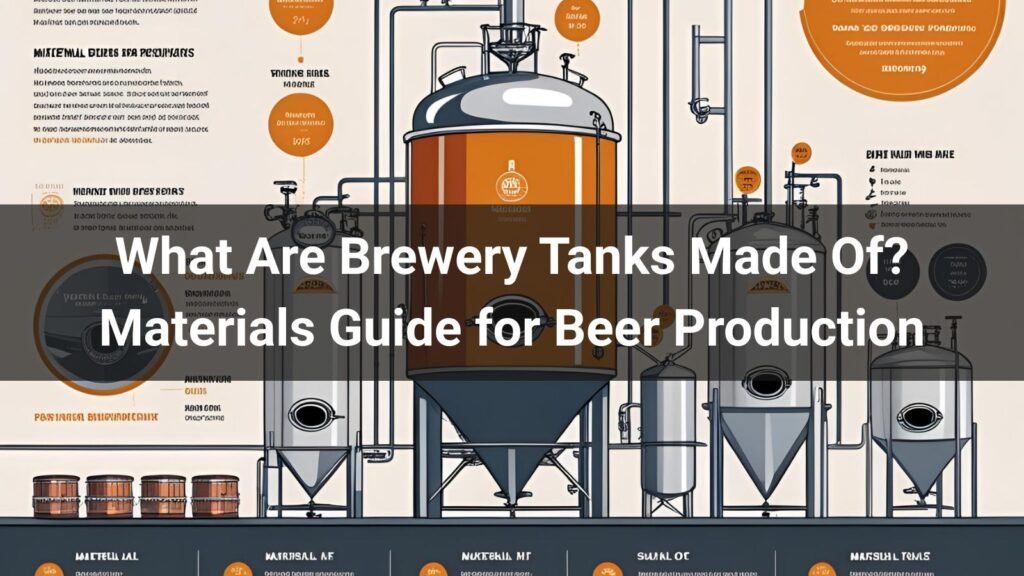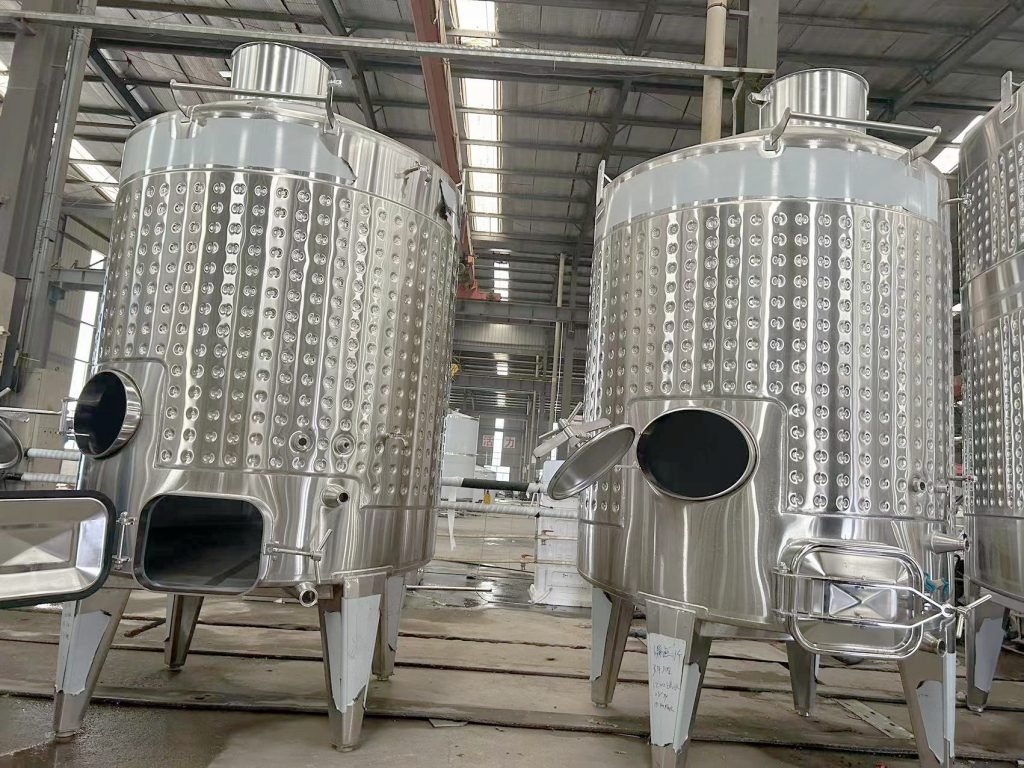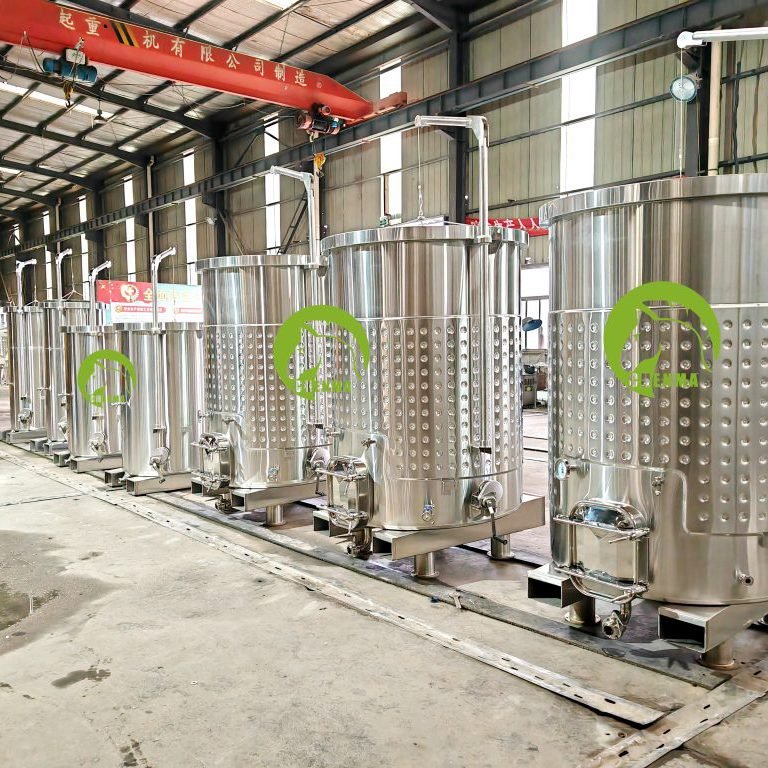
Brewery tanks are predominantly made from stainless steel, specifically grades 304 and 316L, which offer
superior corrosion resistance, durability, and sanitary properties essential for beer production. While
alternative materials like aluminum, plastic, and wood exist, stainless steel remains the industry standard due to
its non-reactive surface, ease of cleaning, and ability to maintain beer quality throughout the brewing process.
Understanding material choices helps brewers make informed decisions about equipment investments and production
quality.
Table of Contents
Stainless Steel: The Primary Choice
Stainless steel dominates brewery tank construction due to its exceptional properties that align perfectly with
brewing requirements. This material offers the ideal combination of durability, hygiene, and performance needed
for consistent beer production.
Why Stainless Steel Dominates
The brewing industry’s preference for stainless steel stems from several critical advantages:
- Corrosion resistance: Withstands acidic beer environments and cleaning chemicals
- Non-reactive surface: Doesn’t impart flavors or odors to beer
- Easy sanitization: Smooth surfaces prevent bacterial growth and enable thorough cleaning
- Temperature stability: Maintains structural integrity across brewing temperature ranges
- Longevity: Provides decades of reliable service with proper maintenance
Historical Context
Before stainless steel became standard, breweries used various materials including wood, copper, and mild steel.
The transition to stainless steel began in the mid-20th century as breweries recognized its superior sanitary
properties and durability benefits.
Industrial
stainless steel tanks have revolutionized brewing operations by providing consistent, contamination-free
environments essential for quality beer production. Professional manufacturers like Shandong Chenma Machinery specialize in
producing high-quality stainless steel tanks for various beverage applications.
Stainless Steel Grades and Properties

Different stainless steel grades offer varying properties, with specific grades preferred for different brewing
applications based on their chemical composition and performance characteristics.
Grade 304 Stainless Steel
Grade 304 stainless steel contains approximately 18% chromium and 8% nickel, making it the most commonly used
grade in brewery tank construction.
| Property | Grade 304 | Brewing Application Benefits |
|---|---|---|
| Corrosion Resistance | Excellent in most environments | Handles typical brewing acids and cleaning agents |
| Cost | More economical | Suitable for budget-conscious operations |
| Weldability | Excellent | Easy fabrication and repair |
| Temperature Range | -196°C to 800°C | Handles all brewing temperatures |
Grade 316L Stainless Steel
Grade 316L stainless steel includes molybdenum (2-3%), providing enhanced corrosion resistance, particularly
against chlorides and acidic environments common in brewing.
Advantages of 316L for Brewing
- Superior corrosion resistance: Better performance in harsh cleaning chemical environments
- Low carbon content: Reduces carbide precipitation and improves weld zone corrosion resistance
- Enhanced durability: Longer service life in demanding brewing applications
- Better performance with CIP systems: Withstands aggressive cleaning chemicals
Material Applications Across Industries
While brewery tanks represent a significant market, stainless steel tank manufacturing extends across multiple
industries:
Wine Production
Wine fermentation tanks utilize similar stainless
steel grades but require specialized features for grape processing. Variable capacity wine tanks demonstrate advanced
engineering using premium stainless steel construction to accommodate different batch sizes while maintaining
optimal wine quality.
Cider Manufacturing
Cider fermentation equipment and specialized cider tanks require stainless steel construction that
handles the acidic nature of fruit-based beverages, demonstrating the versatility of quality stainless steel in
various fermentation applications.
Chemical Processing
Chemical mixing tanks showcase the extreme durability
requirements that stainless steel can meet, often requiring even higher corrosion resistance than brewery
applications. Professional stainless
steel mixing tank manufacturers use advanced grades and construction techniques that benefit brewery tank
production.
Oil and Food Storage
Stainless steel oil tanks demonstrate the material’s
versatility in food-grade storage applications, requiring similar sanitary construction standards as brewery tanks
but with different operational requirements.
Alternative Materials in Brewing
While stainless steel predominates, alternative materials serve specific roles in brewing operations, each
offering unique advantages and limitations.
Aluminum Tanks
Aluminum offers certain advantages for specific brewing applications:
Advantages:
- Lightweight construction
- Excellent thermal conductivity
- Lower initial cost
- Corrosion resistance in many environments
Limitations:
- Reactive with certain cleaning chemicals
- Potential flavor impacts
- Lower durability compared to stainless steel
- Limited use in professional brewing
Food-Grade Plastic Tanks
Plastic materials like HDPE and polypropylene serve niche applications:
| Plastic Type | Advantages | Brewing Applications | Limitations |
|---|---|---|---|
| HDPE | Chemical resistant, lightweight | Storage tanks, small fermenters | Temperature limitations, permeability |
| Polypropylene | Heat resistant, inert | Small-scale brewing, homebrewing | UV degradation, limited durability |
| Polyethylene | Cost-effective, flexible | Temporary storage, transport | Not suitable for long-term use |
Traditional Materials
Copper Tanks
Copper historically played important roles in brewing:
- Excellent heat conductivity
- Natural antimicrobial properties
- Traditional aesthetic appeal
- High maintenance requirements
- Potential copper contamination issues
Wooden Vessels
Wood continues to serve specialized functions:
- Flavor contribution in specialty beers
- Traditional brewing methods
- Barrel aging applications
- High maintenance and contamination risks
Material Selection Factors
Selecting appropriate materials for brewery tanks requires careful consideration of multiple factors affecting
performance, cost, and beer quality.
Chemical Compatibility
Brewery tanks must withstand exposure to various chemicals throughout their service life:
- Beer acids: Lactic, acetic, and other organic acids produced during fermentation
- Cleaning chemicals: Caustic solutions, acid cleaners, and sanitizers
- Sanitizing agents: Peracetic acid, iodine-based, and chlorine-based sanitizers
- Temperature extremes: Hot cleaning cycles and cold storage conditions
Mechanical Properties
Tank materials must provide adequate structural integrity:
- Pressure resistance: Handling fermentation pressure and CIP system pressure
- Impact resistance: Withstanding operational stresses and accidental impacts
- Fatigue resistance: Repeated pressure cycles without failure
- Thermal expansion: Accommodating temperature-related dimensional changes
Hygienic Requirements
Food safety standards drive material selection:
- FDA approval for food contact surfaces
- Easy cleaning and sanitization
- Non-porous surfaces preventing bacterial growth
- Resistance to cleaning chemical degradation
Construction Features and Design

Modern brewery tanks incorporate sophisticated construction features that enhance performance, safety, and
operational efficiency.
Welding and Fabrication
Quality tank construction relies on expert welding techniques:
TIG Welding Standards
- Full penetration welds: Ensuring structural integrity
- Smooth interior finishes: Preventing bacterial harborage points
- Controlled atmosphere welding: Preventing contamination during fabrication
- Post-weld treatment: Passivation to optimize corrosion resistance
Surface Finishes
Interior surface finishes significantly impact cleaning effectiveness and contamination prevention:
| Finish Type | Ra Value (μm) | Applications | Benefits |
|---|---|---|---|
| 2B Mill Finish | 0.5-1.0 | Basic applications | Cost-effective, adequate for most uses |
| 240 Grit Polish | 0.2-0.4 | Standard brewery tanks | Good cleanability, professional appearance |
| 320 Grit Polish | 0.1-0.2 | High-end applications | Superior cleanability, premium finish |
| Electropolish | 0.05-0.1 | Critical applications | Maximum cleanability, corrosion resistance |
Insulation Systems
Thermal management requires appropriate insulation materials:
- Polyurethane foam: Excellent thermal properties, moisture resistance
- Fiberglass: Cost-effective, removable for inspection
- Reflective barriers: Radiant heat protection
- Vapor barriers: Preventing condensation issues
Quality Standards and Certifications
Brewery tank materials and construction must meet rigorous quality standards ensuring safety, performance, and
regulatory compliance.
Industry Standards
ASME Standards
American Society of Mechanical Engineers standards govern pressure vessel construction:
- ASME Section VIII: Pressure vessel design and fabrication
- ASME B31.3: Process piping standards
- Material specifications: Defining acceptable steel grades and properties
- Testing requirements: Non-destructive testing and pressure testing
3-A Sanitary Standards
Sanitary equipment design standards for food processing:
- Surface finish requirements
- Drainage specifications
- Cleanability criteria
- Materials of construction
International Certifications
Shandong Chenma Machinery Co., Ltd. maintains comprehensive certifications ensuring global
quality standards:
- ISO 9001:2015: Quality management systems
- ISO 14001:2015: Environmental management systems
- OHSAS 18001:2007: Occupational health and safety management
- EU CE Certification: European conformity standards
Cost Considerations and ROI
Material selection significantly impacts initial investment and long-term operational costs, making thorough cost
analysis essential for brewery planning.
Initial Investment Factors
Several factors influence brewery tank costs:
| Cost Factor | Impact Level | Description |
|---|---|---|
| Material Grade | High | 316L costs 20-30% more than 304 stainless |
| Wall Thickness | Medium | Thicker walls increase material costs |
| Surface Finish | Medium | Enhanced finishes add 10-25% to costs |
| Tank Size | High | Larger tanks offer better cost per volume |
| Special Features | Variable | Cooling systems, CIP, automation |
Long-Term Value Analysis
Quality stainless steel tanks provide excellent long-term value through:
Operational Benefits
- Reduced contamination losses: Lower product loss rates
- Decreased maintenance costs: Minimal repair requirements
- Energy efficiency: Better insulation and temperature control
- Extended service life: 20-30 years with proper maintenance
Quality Improvements
- Consistent beer quality
- Enhanced shelf life
- Better customer satisfaction
- Premium market positioning
Maintenance and Durability
Proper maintenance of brewery tank materials ensures optimal performance and extends equipment lifespan, directly
impacting operational efficiency and product quality.
Stainless Steel Maintenance
Maintaining stainless steel brewery tanks requires systematic approaches:
Cleaning Protocols
- Pre-rinse: Remove gross contamination with water
- Alkaline wash: Remove protein and organic deposits
- Acid rinse: Eliminate mineral scales and restore surface passivity
- Sanitization: Final microbial elimination before use
Inspection Procedures
Regular inspections prevent minor issues from becoming major problems:
- Visual inspections: Looking for discoloration, pitting, or damage
- Passivity testing: Ensuring optimal corrosion resistance
- Weld inspection: Checking for cracks or deterioration
- Gasket and seal assessment: Preventing contamination pathways
Common Material Issues
Understanding potential material issues helps prevent problems:
| Issue | Causes | Prevention | Solutions |
|---|---|---|---|
| Pitting Corrosion | Chloride exposure, poor passivation | Proper cleaning, avoid chlorinated cleaners | Re-passivation, surface repair |
| Stress Corrosion | High stress, corrosive environment | Proper design, stress relief | Structural modification, material upgrade |
| Crevice Corrosion | Poor drainage, dead zones | Eliminate crevices, improve drainage | Design modification, enhanced cleaning |
| Heat Tinting | Improper welding, oxidation | Controlled atmosphere welding | Mechanical removal, re-passivation |
Professional Support and Expertise
Shandong Chenma Machinery Co., Ltd. provides comprehensive support for brewery tank materials
and construction. Our experienced team of over 200 professionals ensures optimal material selection and
construction quality for lasting performance.
Located in Pingyuan County Economic Development Zone, Dezhou City, Shandong Province, our 20,000 m² production
facility utilizes state-of-the-art machinery to manufacture brewery tanks meeting the highest quality standards.
We specialize in brewing
tanks and fermenters with advanced features including conical designs and CIP systems.
For technical consultation and equipment specifications, reach us at:
WhatsApp: 008618063421809
Email: admin@sdchenma.com
Material Innovation Trends
The brewery industry continues evolving with material innovations:
- Advanced stainless grades: Improved corrosion resistance and strength
- Hybrid constructions: Combining materials for specific benefits
- Surface treatments: Enhanced cleanability and antimicrobial properties
- Smart materials: Integrated sensors for monitoring and control
Conclusion
Brewery tanks are primarily constructed from stainless steel grades 304 and 316L, chosen for their exceptional
corrosion resistance, sanitary properties, and durability. While alternative materials like aluminum, plastic, and
traditional materials serve specific purposes, stainless steel remains the gold standard for professional brewing
operations.
Material selection impacts every aspect of brewery operations, from initial investment costs to long-term product
quality and maintenance requirements. Understanding these material properties helps brewers make informed
decisions that optimize both performance and value.
The key to successful brewery tank material selection lies in balancing immediate costs with long-term benefits,
ensuring chosen materials meet both current needs and future expansion plans while maintaining the highest
standards of beer quality and safety.
For expert guidance on brewery tank materials and construction, contact Shandong Chenma
Machinery:
Address: Pingyuan County Economic Development Zone, Dezhou City, Shandong Province
WhatsApp: 008618063421809
Email: admin@sdchenma.com



